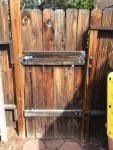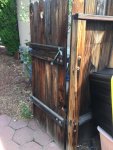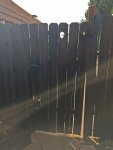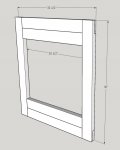- Messages
- 36,132
- Location
- ABQ NM
I'm replacing a worn-out gate on our side yard fence.



The two 4x4 gateposts are not plumb or square, but they're solidly anchored in concrete. They are staying.
I've built a frame for the new gate, and I'll attach dog-eared red cedar boards to it. (As funds permit, I'll be replacing the whole fence to match.)
Here's a sketch of the frame, missing a few details like carriage bolts at the lap-jointed corners and other screws. In addition to metal fasteners, the joints are glued with Titebond III and everything is square. Since the opening isn't square, the frame will have about 1/4" gap between the posts on each side at the top, and about 3/4" gap on each side at the bottom. That gap will be hidden by the slats, though.

Now to the question: Would you mount the hinges on the gatepost, and then hang the gate on them, or would you mount the hinges on the gate first, and then attach it to the gatepost?
I built the frame yesterday, and was going to finish it up today, but I threw my back out (closing the sliding glass door to the patio, of all things), so it looks like I'll have until next weekend to ponder my approach to finishing things up.



The two 4x4 gateposts are not plumb or square, but they're solidly anchored in concrete. They are staying.
I've built a frame for the new gate, and I'll attach dog-eared red cedar boards to it. (As funds permit, I'll be replacing the whole fence to match.)
Here's a sketch of the frame, missing a few details like carriage bolts at the lap-jointed corners and other screws. In addition to metal fasteners, the joints are glued with Titebond III and everything is square. Since the opening isn't square, the frame will have about 1/4" gap between the posts on each side at the top, and about 3/4" gap on each side at the bottom. That gap will be hidden by the slats, though.

Now to the question: Would you mount the hinges on the gatepost, and then hang the gate on them, or would you mount the hinges on the gate first, and then attach it to the gatepost?
I built the frame yesterday, and was going to finish it up today, but I threw my back out (closing the sliding glass door to the patio, of all things), so it looks like I'll have until next weekend to ponder my approach to finishing things up.



